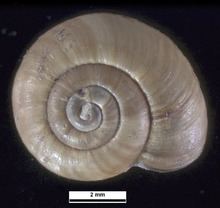Genus Notodiscus Rank Species | ||
 | ||
Notodiscus hookeri is a species of small air-breathing land snail, a terrestrial gastropod mollusk in the family Charopidae. This snail lives on islands in the sub-Antarctic region. Its shell is unique among land snails in that the organic part of the shell layers contains no chitin.
Contents
Taxonomy
This species was described under the name Helix hookeri by an English conchologist Lovell Augustus Reeve in 1854. The specific name hookeri is in honor of English botanist Joseph Dalton Hooker, who collected this snail during the Antarctic expedition led by James Clark Ross. Reeve's type description reads in Latin and in English language as follows:
Henry Augustus Pilsbry classified this species as Helix hookeri in 1887 or within the genus Amphidoxa as Amphidoxa hookeri within the family Endodontidae in 1894.
Also Alan Solem classified this species within the family Endodontidae in 1968.
A subspecies Notodiscus hookeri heardensis Dell, 1964 was recognized in Heard Island.
Distribution
Notodiscus hookeri has a wide distribution in the sub-Antarctic region. It is the only native terrestrial gastropod species found in the South Indian Ocean islands and archipelagos, and also in the South Atlantic Province:
South Indian Province:
South Atlantic Province:
The type locality is the Kerguelen Islands.
The land snail Notodiscus hookeri is not an endangered or a protected species.
Shell description
The shell growth does not stop on reaching sexual maturity, but decelerates considerably, with the biggest shells measuring 7.5–7.7 mm in size.
Large intraspecific variations in shell morphometrics have been reported for this species on Possession Island, with endemic variants being described as local adaptations to environmentally distinct islands.
The shape of the shell is depressed. The umbilicus is open.
The width of the adult shell is up to 7.5-7.77 mm.
The micro structure of the shell was analysed by Charrier et al. (2013). Their study was the first to demonstrate that gastropod shell micro structure responds to environmental heterogeneity, leading to the formation of ecophenotypes. The adults of Notodiscus hookeri have evolved into two ecophenotypes, which the authors referred as MS (mineral shell) and OS (organic shell):
Notodiscus hookeri has unique shell micro-scale structure among gastropods:
Ecology
This land snail is a gregarious species that lives under moist stones, moss and wet vegetation; however, it is also widespread in fell-field areas, which are characterised by very low vegetation cover.
The soil is known to be a nutrient resource for Notodiscus hookeri, since this species has been found to significantly increase calcium release in solutions derived from plant litter.
Hatchlings have a shell width of < 2.0 mm. Juveniles have a shell width of about 2.0-4.0 mm. Adults have a shell width larger than 4.0 mm.
The biology of this species is poorly known.
On a stamp
Notodiscus hookeri was depicted on the 2012 €0.60 French Southern and Antarctic Lands postal stamp.
